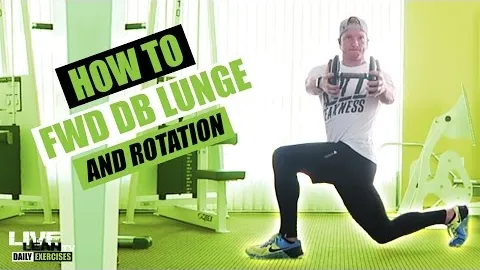
Are you looking for a challenging full-body exercise that targets multiple muscle groups at once? Look no further than the forward dumbbell lunge and rotation. This compound movement not only engages your lower body but also activates your core, shoulders, and upper back. In this comprehensive guide, we will walk you through the proper form, benefits, variations, and precautions of the forward dumbbell lunge and rotation exercise.
Incorporating forward dumbbell lunge and rotation into your workout routine comes with several benefits:
The forward dumbbell lunge and rotation exercise engages multiple muscle groups simultaneously. Your lower body muscles, including quadriceps, hamstrings, glutes, and calves, are activated during the lunge phase. At the same time, the rotational movement engages your core muscles, obliques, shoulders, and upper back.
As you perform the forward dumbbell lunge and rotation, your body has to work to maintain stability and balance. This helps strengthen the stabilizer muscles in your hips and core, enhancing your overall balance and coordination.
The rotational component of this exercise places a significant emphasis on your core muscles. By incorporating the forward dumbbell lunge and rotation into your routine, you can develop a strong and stable core, which is essential for maintaining good posture and preventing injuries.
The forward dumbbell lunge and rotation exercise mimics movements that are commonly performed in daily activities and sports. By incorporating this exercise into your training, you can improve your overall functional movement patterns and perform daily tasks with greater ease and efficiency.
Compound movements like the forward dumbbell lunge and rotation require significant energy expenditure. By engaging multiple muscle groups, these exercises elevate heart rate and promote cardiovascular health while helping you burn calories and improve overall fitness.
Once you have mastered the basic forward dumbbell lunge and rotation, you can incorporate variations to add variety and challenge to your workouts. Here are a few notable variations:
As you become more comfortable with the movement, you can increase the intensity by using heavier dumbbells or kettlebells. The added weight will not only increase the challenge but also promote strength development.
Instead of stepping forward, step backward into the lunge motion while performing the rotation. This variation puts a different emphasis on your muscles and challenges your coordination in a different way.
Add an extra challenge by incorporating a twist as you rotate. Start with your palms facing inwards, and as you rotate, twist your wrists and let your palms face upwards.
While the forward dumbbell lunge and rotation exercise offers numerous benefits, it is crucial to perform it with proper form and technique to avoid any potential injuries. Here are a few precautions and tips to keep in mind:
The forward dumbbell lunge and rotation exercise is an effective compound movement that offers numerous benefits for all fitness levels. Whether you are a beginner or an advanced exerciser, this exercise engages multiple muscle groups, improves balance and stability, strengthens your core, and enhances your functional movement patterns. By incorporating variations and following proper form, you can enjoy the full benefits of this exercise while minimizing the risk of injuries. So, add the forward dumbbell lunge and rotation to your workout routine and experience a stronger, fitter, and more functional body.
If you're looking for a gym, fitness club or yoga studio, you've come to the right place.
You can find information about gyms in your area. Browse catalog of gyms and find gyms with classes which are you looking for.
On gym page you can find simple information like address, phone or website. You can find list of available classes. You can check availability of personal training or small group classes. On place page you can also see information about open hours.
You can find gyms near you with amenities, courts, studios and equipments.
Use our map to find gym at your city or district.
In Gym Navigator you can find list of exercises with movies for many body parts.
You can browse exercises catalog and find exercises the best of you.
You can also find exercises grouped into workout plans, which you can use to improve you body. Each routine show you exercises one by one and give you possibility to count you progress and count down rest time.